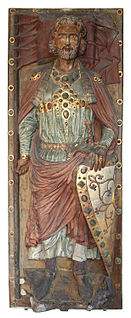External links
- Peter Neumeister: Gerung in Institut für Sächsische Geschichte und Volkskunde (ed.): Sächsische Biografie (in German)
Gerung (died 20 November 1170) was bishop of Meissen from 1152 to 1170, and previously abbot of Posa or Bosau Abbey.
His time as bishop is particularly remembered for the treaty which he agreed in 1154 with the immigrant Flemish settlers in Kühren. Also during Gerung's time in office Vladislaus II, Duke of Bohemia, because of border disputes with the Margravate of Meissen, overran the territory of the bishopric and caused much destruction, for which when he became king he compensated the bishop.
In 1160 Gerung took part with other bishops in an Imperial Diet in Erfurt, to discuss the suppression of the revolt in Milan against Emperor Frederick I. In 1163 he sat in judgment with the Emperor on the murderers of Archbishop Arnold of Selenhofen in Mainz, with serious consequences for the city, which suffered the loss of several important rights.
Gerung fell ill during a visit to Petersberg Abbey and died there. His body was transported for burial to Meissen Cathedral.

Saint Afra was martyred during the Diocletian persecution. Along with Saint Ulrich, she is a patron saint of Augsburg. Her feast day is August 7. Afra was dedicated to the service of the goddess, Venus, by her mother, Hilaria. Through his teachings, Bishop Narcissus converted Afra and her family to Christianity. When it was learned that Afra was a Christian, she was brought before Diocletian and ordered to sacrifice to the pagan gods. She refused, and was condemned to death by fire.

Henry I, known as Henry the Strong, was the Margrave of Austria from 994 to his death in 1018. He was a member of the House of Babenberg.

Benno was named Bishop of Meissen in 1066. Venerated since the 13th century, he was canonized in 1523. Benno did much for his diocese, both by ecclesiastical reforms on the Hildebrandine model and by material developments. He was venerated in his native Saxony throughout the later Middle Ages.
Gertrud of Brunswick was Countess of Katlenburg by marriage to Dietrich II, Count of Katlenburg, Margravine of Frisia by marriage to Henry, Margrave of Frisia, and Margravine of Meissen by marriage to margrave Henry I. She served as regent of the County of Katlenburg during the minority of her son Dietrich III of Katlenburg, and as regent of the County of Northeim during the minority of her son Otto III of Northeim. She was also one of the leaders of the insurrections against Emperor Henry IV and his son Henry V.
The Bishopric of Merseburg was an episcopal see on the eastern border of the medieval Duchy of Saxony with its centre in Merseburg, where Merseburg Cathedral was constructed. The see was founded in 967 by Emperor Otto I at the same time in the same manner as those of Meissen and Zeitz, all suffragan dioceses of the Archbishopric of Magdeburg as part of a plan to bind the adjacent Slavic ("Wendish") lands in the Saxon Eastern March beyond the Saale River more closely to the Holy Roman Empire.

Wiprechtof Groitzsch was the Margrave of Meissen and the Saxon Ostmark from 1123 until his death. He was born to a noble family of the Altmark, the son of Wiprecht of Balsamgau and Sigena of Leinungen. After his father's death in 1060, he was raised at the court of Lothair Udo II, Margrave of the Nordmark, in Stade.
Henry VI of Plauen was Burgrave of Meissen, Lord of Plauen and Lord of Schleiz and Lobenstein.

Severinus of Saxony was a Saxon prince of the Albertine line of the House of Wettin.

Hedwig of Brandenburg, also called Hedwig of Ballenstedt, a member of the House of Ascania, was Margravine of Meissen from 1156 until 1190 by her marriage with Margrave Otto II.
Margrave Conrad II of Lusatia, also known as Margrave Konrad II of Landsberg, was a member of the House of Wettin. He was Count of Eilenburg and Margrave of Lusatia from 1190 until his death. From 1207, he was also Count of Groitz and Count of Sommerschenburg. He was a son of Margrave Dedi III and his wife, Matilda of Heinsberg, the heiress of Sommerschenburg.
Saint Burchard of Meissen was the first Bishop of Meissen, from 968.
Hugbert of Meissen was Bishop of Meissen from 1023 to 1024.
Dietrich I, otherwise Theoderich, was Bishop of Meissen from 1024 to late 1039 or early 1040.
Albrecht I of Meissen was Bishop of Meissen from 1150 to 1152.
Martin was Bishop of Meissen from 1170 to 1190.
Dietrich von Kittlitz otherwise Dietrich II of Meissen or Dietrich II von Kittlitz was Bishop of Meissen from 1191 to 1208.
Bruno von Porstendorf otherwise Bruno II of Meissen or Bruno II von Porstendorf was Bishop of Meissen from 1209 to 1228.
Heinrich of Meissen was Bishop of Meissen from December 1228 to his death.
Albrecht von Mutzschen otherwise Albrecht II of Meissen or Albrecht II von Mutzschen was Bishop of Meissen from 1258 to 1266.
Withego von Furra or de Wuor, otherwise Withego I of Meissen or Withego I von Furra was Bishop of Meissen from 1266 to his death.